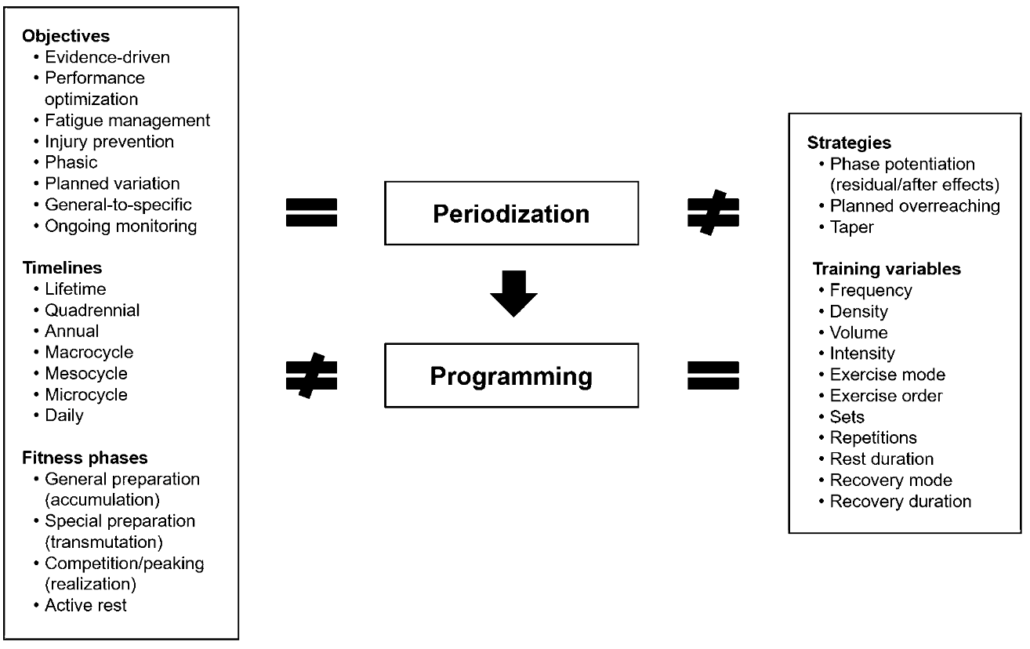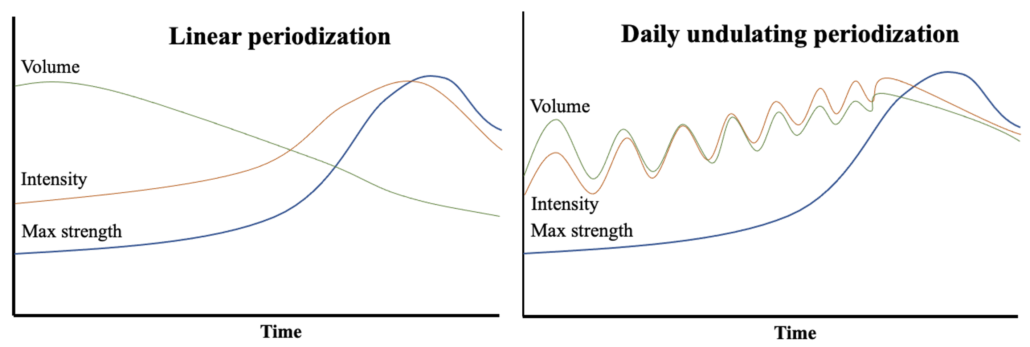Training – Daily Undulating Periodisation (DUP)
Als onderdeel van de specialisatie MSc. Strength and Conditioning (St Mary’s University, Twickenham – London) heb ik het onderstaande stuk geschreven betreffende Daily Undulating Periodization (DUP). Dit is een specifieke wijze van het organiseren van verschillende trainingen binnen eenzelfde week om effectief resultaten te bereiken. Überhaupt is het organiseren van je training effectiever dan het niet gebruiken van een specifieke systematiek. DUP leidt tot een betere ontwikkeling van maximaal kracht in vergelijking tot lineaire en strength-power modellen. Resultaten op het gebied van hypertrofie zijn vergelijkbaar. Echter is de voorspelbaarheid van deze resultaten, de transfer naar sport en definiëring van specifieke trainingsmodellen een onderwerp van veel discussie.
A deep dive into daily undulating periodization
Critically evaluative, evidence based education content
Periodization is a broadly accepted and applied scientific training methodology (Afonso et al., 2017; Bompa & Haff, 2009; Cunanan et al., 2018; Fisher & Csapo, 2021; Harries et al., 2015; Kiely, 2012; Selye, 1952). A recent review recommended the following definition based on eighty-seven sources dating back from 1981 until 2020: ‘Periodization is an organizational approach to training that considers the competing stressors within an athlete’s life and creates “periods” of time dedicated to specific outcomes (i.e., strength, hypertrophy or power). These designated periods are intended to manage the stress associated with exercise, while also creating potentiation in the subsequent training phases. Through proper stress management and program design this approach may also attempt to peak various performance measures at a specific time relevant to competition” (Kataoka et al., 2021). Herewith it is assumed that training stimuli will give predictable and even forecastable biological adaptations (Kiely, 2012). For example, recovery is vital in both the short term between training sessions (hours to days) and between training phases (deload periods) to allow physiological adaptation and prevent non-functional overreaching, figure 1 (Bell et al., 2022; Chiu & Barnes, 2003; Cunanan et al., 2018; Fisher et al., 2018; Helland et al., 2020; Soligard et al., 2016).
However, it has been found that there are considerable inter-individual differences following exercise (Afonso et al., 2017). The large number of variables and uncertainties regarding the outcome creates a complex puzzle for a coach or clinician, whereby periodization is more than just the programming of sets, reps and load, see figure 2 (Cunanan et al., 2018). It requires a detailed numerical expression of the variables for each repetition within each training of a certain macro-, meso- and microcycle to contribute to the desired goal (González-Badillo et al., 2022). The effort to create a proper periodized program could have its benefits. In regard to increasing maximal strength it has been suggested in two meta-analysis that periodized training was more effective than non-periodized resistance training (Moesgaard et al., 2022; Williams et al., 2017). And training adherence is seen to be higher due to increased motivation, prevention of negative mood states, burn out and boredom (Clemente-Suárez et al., 2021).
The periodization of training knows many variants, i.a. there are traditional/linear, block, reverse and undulating approaches (González-Ravé et al., 2022). Poliquin (1988) was an early advocate of undulating training methods. He argued that it was of the ‘utmost importance’ to use variations in volume and intensity because the efficacy of neuromuscular adaptation would quickly decline after two weeks. Also, a continuous increase of intensity in linear periodization would lead to insufficient recovery time. There are several set-ups in undulating periodization methods and these are mainly distinguished in the fact that the volume and intensity are varied daily or weekly (Harries et al., 2015; Moesgaard et al., 2022). In regard to daily undulating periodization (DUP), an athlete could, for example, perform hypertrophy training on Monday, (sub-)maximal strength training on Wednesday and power training on Friday (Tammam & Hashem, 2015). Similar but different, sequences of hypertrophy, power and strength have also been researched (Zourdos et al., 2016). During the week the intensity increases and volume decreases possibly converging to peaking performance. Depending on the needs of the athlete repetition ranges can be: 12-25 (strength endurance), 8-12 (hypertrophy), 4-6 (power) and 2-4 (strength). Whereby untrained individuals can improve function with strength endurance, but trained athletes need intensities of >80% 1RM to enhance performance outcomes (Hartmann et al., 2015). It has been suggested that implementing variation in exercises between these days might enhance muscle hypertrophy, because each exercise will target portions of a muscle in different way (Buckner et al., 2020; Fisher et al., 2018). It is questionable however, whether this is really the case.
In the last fourteen years, six reviews have compared the impact of DUP compared to other periodization models in relation to different outcome measures like maximal strength and muscle hypertrophy (Bernárdez-Vázquez et al., 2022; Evans, 2019; Fröhlich et al., 2009; Grgic et al., 2017; Hartmann et al., 2015; Moesgaard et al., 2022). Most often DUP was compared with linear periodization. In regard to muscle hypertrophy, the reviews collectively agree that both strategies result in equal hypertrophy gains (Bernárdez-Vázquez et al., 2022; Evans, 2019; Grgic et al., 2017; Moesgaard et al., 2022). Once again confirming that training volume is a dominant variable in modulating a desired hypertrophy response (Bernárdez-Vázquez et al., 2022; Schoenfeld et al., 2017). With this in mind, choosing the right periodization model comes down to different arguments. Either in relation to other training goals that need to be achieved in the same period, enjoying the extra variations which accompanies DUP or using a linear model in which progress could be easier noticeable and therefore more rewarding. In the latter case it is advised to use a reversed linear model because this leads to an increased training volume down the road which is directly related to the development of hypertrophy (Bernárdez-Vázquez et al., 2022). However, practitioners must be careful not to make the false assumption that a greater muscle size will lead to a higher force production. This relationship lacks evidence (Buckner et al., 2016, 2018; Mattocks et al., 2016).
In contrast to the development of muscle hypertrophy, the rate of development of maximal strength is influenced with different periodization models. DUP appears to lead to superior effect in increasing maximal strength compared to linear periodization (Evans, 2019; Fröhlich et al., 2009; Moesgaard et al., 2022). It should be taken into account that this appears to be true in relation to trained individuals (Moesgaard et al., 2022). When DUP is compared with strength-power periodization models, the former leads to greater increases in one repetition max with athletes of low to moderate performance levels (Hartmann et al., 2015). The rationale for this higher increase in maximal strength in these comparisons is attributed to a greater amount of variation which induces more neurophysiological adaptations (González-Badillo et al., 2022; Moesgaard et al., 2022; Poliquin, 1988). With variation consisting of systematically altering specific training variables over time to keep providing a progressive overload to the body (González-Badillo et al., 2022). Physiological enhancement can be the result of changes at (supra-)spinal levels through; increasing the descending drive, a-motoneuronal net excitation and/or inhibitory synaptic inputs. This can result in higher motor unit recruitment and discharge rates in combination with improved inter- and intramuscular coordination (Moesgaard et al., 2022). In a critical narrative towards a new paradigm González-Badillo et al. (2022) strongly argue that the prescription of the dominant variables should be very specific. The relative load in combination with the degree of fatigue are the main variables that determine the performed effort. And to be able to assess the relative load, the desired velocity and velocity loss of the movement during each repetition, session and cycle should be specified.
Coaches should take note that there are multiple considerations before applying DUP to improve the maximal strength of their athletes. First of all, research studies use concepts of periodization and variation interchangeable and have used different interpretations of DUP. Second, as is part of the aforementioned definition, the use of periodization should lead to predictable peak performance, but this predictability is not being tested in the studies. Third, most studies had a protocol between six to twenty-two weeks which only gives insight into short term adaptations. Fourth, most studies ignore variation in inter-individual responsiveness. And finally, the causal relationship between improved maximal strength and sport performance is not clear. It is argued that not variation but specificity is the distinctive variable in better sport performance and improved maximal strength mainly contributes to injury prevention (Afonso et al., 2017; Buckner et al., 2018, 2020).
The concept of periodization in resistance training is a topic of much debate. Periodization appears to lead to better improvements compared to no periodization. DUP shows superior improvements in maximal strength development compared to linear and strength-power models, but has similar increases in muscle hypertrophy as the former. And with the format of DUP possibly leading to more variation, it is important to simultaneously keep a close eye on specificity during exercise selection, the prescription of load and the velocity of movement in regard to actual effort. The predictability of expected results and the transfer to sport performance is unfortunately uncertain to date.






 MacDonald, B., McAleer, S., Kelly, S., Chakraverty, R., Johnston, M., & Pollock, N. (2019). Hamstring rehabilitation in elite track and field athletes: Applying the British Athletics Muscle Injury Classification in clinical practice. British Journal of Sports Medicine, 53(23), 1464–1473
MacDonald, B., McAleer, S., Kelly, S., Chakraverty, R., Johnston, M., & Pollock, N. (2019). Hamstring rehabilitation in elite track and field athletes: Applying the British Athletics Muscle Injury Classification in clinical practice. British Journal of Sports Medicine, 53(23), 1464–1473 Giannini, S., Buda, R., Mosca, M., Parma, A., & Di Caprio, F. (2013). Posterior ankle impingement. Foot and Ankle International, 34(3), 459–465
Giannini, S., Buda, R., Mosca, M., Parma, A., & Di Caprio, F. (2013). Posterior ankle impingement. Foot and Ankle International, 34(3), 459–465